Are you aware of all of the targeting options Facebook offers?
Facebook offers so many ways to target potential customers, there's a right advertising option for every business.
In this article you'll find 21 ways to target specific audiences with Facebook advertising.
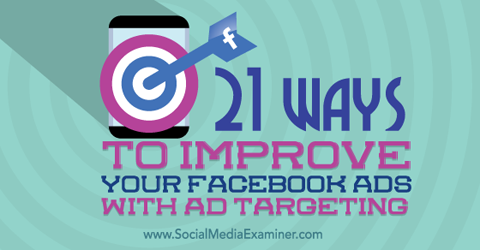
Listen to this article:
Where to subscribe: Apple Podcasts | Spotify | YouTube Music | YouTube | Amazon Music | RSS
#1: Know Your Customers' Interests
On Facebook, you can target people who have expressed an interest in or like pages related to another page or topic. This is interest-based targeting, although it is commonly confused with “likes” targeting.
There are thousands of interests to target, and they're located in the Interests section of your ad set settings.

Type literally anything into the search box and Facebook will suggest matching or related interests.
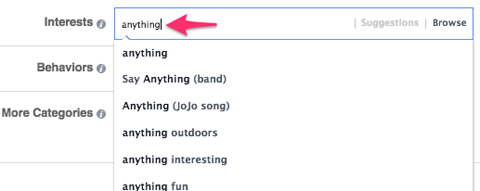
Interest targeting usually means that you're targeting large audiences. So before you set up interest targeting, evaluate the size of your target group. Then consider combining an interest with at least one other targeting method.
#2: Seek Out People in the Market for What You Sell
Our online behavior tells platforms a lot about our buying intentions. By combining data from different sources, Facebook is able to tell who is in the process of buying a given product.
Therefore, you can target people who are looking to buy something specific; for example, new vehicle shoppers in the market for a luxury SUV.
This option is located in the Behavior section of the ad set settings.
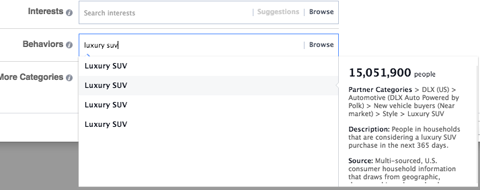
You'll see multiple categories in a scenario like this, because Facebook allows you to be that specific. In the case of the SUV, target people who are looking for a new SUV, a used SUV and so on.
Experiment with this targeting option to determine which methods are most profitable.
Get World-Class Marketing Training — All Year Long!
Are you facing doubt, uncertainty, or overwhelm? The Social Media Marketing Society can help.
Each month, you’ll receive training from trusted marketing experts, covering everything from AI to organic social marketing. When you join, you’ll also get immediate access to:
- A library of 100+ marketing trainings
- A community of like-minded marketers
- Monthly online community meetups
- Relevant news and trends updates
#3: Target People Based on Financial Resources
If you want to sell a product or service that is tied to affordability, this method is extremely useful. Listed under Demographics, this targeting option allows you to select among Income, Net Worth and Liquid Assets.

Liquid Assets is an option under Net Worth.
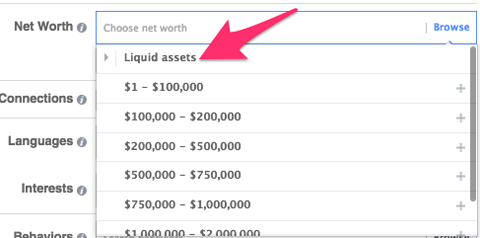
Targeting people by income, net worth or liquid assets usually works well as a stand-alone option. When businesses combine it with a behavior that best matches their target group, the audiences are often too narrow. The trick is to choose a broader behavior than usual in case the audience turns out to be small (for example 10-20K).
According to Facebook Power Editor, their data is “Modeled based on age, income, presence of children, occupation, property data, vehicle data, investment interest and census median data.”
#4: Combine Age and Gender With Where People Live
Instead of simply targeting geographic areas, add age groups and gender to the mix. For example, target men ages 25-35 who live in New York City.
This is based on the first information people share when they create a Facebook profile: age, gender and city they live in. Targeting people based on where they live can also be a great substitute for targeting certain income levels, because it presumes a certain quality of life.
This method can be used right after setting up an ad set.
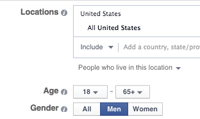
Target virtually any state, region and city in the world (with a few exceptions). Another option is to exclude part of a region to optimize your ads even further.
A few selected countries, such as the United States, also support zip code targeting.
#5: Target People by Industry or Occupation
For products or services that are ideal for people who work in a given industry or have a specific job, use industries or job title for the targeting method. For example, target “Employed in Arts, entertainment, sports and media.”
This is located under Work (below Demographics) on Facebook.

The industry people work in can be a great alternative to simply targeting by office type.

In fact, office type targeting actually allows you to target three more small office categories.
#6: Promote to People Based on Homeownership Status
Just as Facebook can target people who are planning to buy something specific (like a car), the platform is also able to target people based on their homeownership status.
However, Facebook classifies homeownership as a demographic and not as a behavior, as it does with cars and other products. Target homeowners, renters or first-time homebuyers.

Additional targeting options include home type and household composition.
#7: Filter by Level of Education and Academic Degrees
Zeroing in on education level, academic field and other related topics is a great targeting method for products that are not appropriate for the entire population. Hone in on college grads, doctorate degrees and people who studied something specific.
For example, to market a professional résumé-building service for graduates, use this method to eliminate traffic that doesn't match your user profile.
Education is a subcategory of Demographics.

Combine education with another targeting method to be as relevant as possible with the ads.
#8: Target Ethnic Affinities
If appropriate for your brand, target Ethnic Affinities, such as African American, Asian American or Hispanic. This option is available under Demographics.

This targeting method is only available in the United States. The data is based on people who live in the United States whose activity on Facebook aligns with a given ethnic affinity.
#9: Reach Out to Parents
Many ecommerce sites have parents and kids as a primary audience.

Discover Proven Marketing Strategies and Tips
Want to go even deeper with your marketing? Check out the Social Media Marketing Podcast! Publishing weekly since 2012, the Social Media Marketing Podcast helps you navigate the constantly changing marketing jungle, with expert interviews from marketing pros.
But don’t let the name fool you. This show is about a lot more than just social media marketing. With over 600 episodes and millions of downloads each year, this show has been a trusted source for marketers for well over a decade.
Facebook not only allows targeting of parents, it lets you narrow the parents based on the age of their kids.
This option is listed under Demographics.

This category also includes a section dedicated to moms and their lifestyle. Subcategories include Big City Moms, Corporate Moms, Fit Moms, Green Moms, Moms of High School Kids and more.
#10: Target by Generation
Baby Boomers, Generation X and Millennials pretty much define three completely different customer behaviors. They definitively help to narrow down the targeting options of many businesses.
The Generation tab is located under Demographics.

Facebook defines these categories based on the birth year of the users in each category.
#11: Filter by Political Beliefs
You can target political beliefs (conservative, liberal or moderate) with your Facebook ad account.
Political data is available in Demographics for the United States only.

There is a section called Self Reported, which includes information based on self-reported data or donations. Facebook doesn't have a source section listed for each of the political parties. Therefore, we don't have an official answer to where they get this data.
#12: Reach Out to Those With an Upcoming Anniversary
This category targets people with an anniversary within 30 days. Since there is a deadline to a couple's milestone, it's an excellent opportunity to drive people to a sale.
Find upcoming anniversaries in the Life Events subcategory of Demographics.

This is a great way to find people who have a reason to buy a present.
#13: Find Friends of People Celebrating a Milestone
Just like those about to celebrate an anniversary, it's also possible to target the friends of people who have an upcoming birthday. It's in the Friends subcategory in Life Events.

Again, this is a great way to push sales to gift-givers.
#14: Find People in a Long-distance Relationship
Targeting a long-distance relationship is another great way for businesses and service providers to sell more gifts and vouchers.
This option is a subcategory of Life Events.

Ecommerce solutions for people in a long-distance relationship benefit from this sort of targeting.
#15: Target Those Away From Family or Home
Other life events that may interest businesses are people away from family or home.

Facebook seems to be using location information in accounts to retrieve this data for advertising purposes.
#16: Promote to People Who Recently Started a Job
People who just started a new job or got promoted at their existing one could be good targets for a clothing or accessory company. They may want to dress to impress at their new gig and may shop online.
Target people starting a new job using the Life Events option in Demographics.

Facebook retrieves this data from profile updates. Target people who changed their job over the past 6 months.
#17: Target People Who Love to Shop
Marketing to online buyers in households with many lifetime online purchases is much better than targeting just anyone, especially people who are unlikely to complete an online purchase.
This targeting method is listed under Behaviors.

Combine this behavior with other targeting methods to reach the largest possible portion of potential customers who are likely to buy online.
#18: Reach Out to People Who Live in Expensive Homes
Target people living in houses worth more than $1 million if your business offers premium goods or services such as home insurance.
Home values are included in Demographics under Home Type in the subcategory Home Value.

Try different targeting options, depending on what you're promoting. For example, create one ad set focusing merely on home value and another that combines it with other targeting methods. Then see what works best for your business.
#19: Find Gamers
People who connect to Facebook from gaming consoles can be targeted with Facebook ads. You can even target people who have played a game on Facebook within the past 14 days.
This option is listed under Behaviors.

Gamers also typically like pages related to console games or gaming systems.
#20: Seek Out Page Admins
If you have a tech product or service that could improve business and productivity for page admins, target them.
This is listed on Facebook as a Behavior.

This targeting is perfect for apps, web-based services and other tools that are targeting page admins on Facebook.
#21: Target People Who Own Specific Mobile Devices
Facebook allows you to target people based on the mobile device they use to log into Facebook.
This method is available in the Behaviors section.

This targeting comes in handy for companies selling phones and accessories or for businesses that offer apps.
In Conclusion
While many marketers and business owners believe Facebook ad targeting options are too limited or too general, that's not the case. There are a ton of targeting options and combinations out there.
Facebook is a goldmine of data and is definitely a good choice for the vast majority of businesses. This is just a selection of target audiences, among hundreds of options, available to anyone using the Facebook Ads interface.
Facebook ads are effective. Take the time to research different target methods to find the ones that best fit with your business, so you can create successful Facebook ad campaigns.
What do you think? Which combinations have you tried? What targeting works best for your business? Please share your thoughts and recommendations in the comments.
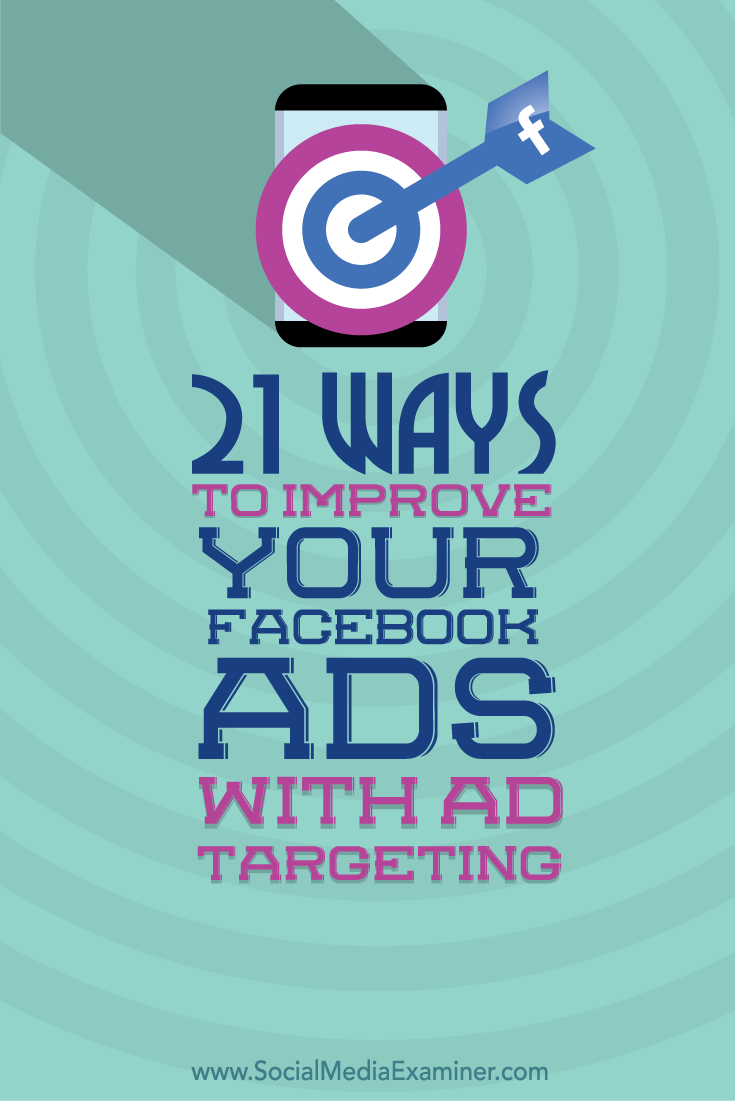
Attention Agency Owners, Brand Marketers, and Consultants

Introducing the Marketing Agency Show–our newest podcast designed to explore the struggles of agency marketers.
Join show host and agency owner, Brooke Sellas, as she interviews agency marketers and digs deep into their biggest challenges. Explore topics like navigating rough economic times, leveraging AI, service diversification, client acquisition, and much more.
Just pull up your favorite podcast app, search for Marketing Agency Show and start listening. Or click the button below for more information.


